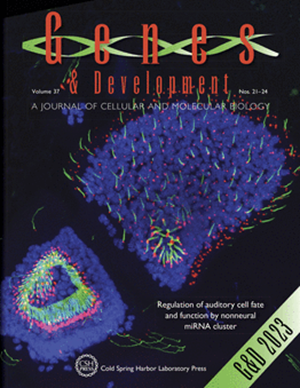Two unrelated distal genes activated by a shared enhancer benefit from localizing inside the same small topological domain
IF 7.7
1区 生物学
Q1 CELL BIOLOGY
引用次数: 0
Abstract
Enhancers are tissue-specific regulatory DNA elements that can activate transcription of genes over distance. Their target genes most often are located in the same contact domain—chromosomal entities formed by cohesin DNA loop extrusion and typically flanked by CTCF-bound boundaries. Enhancers shared by multiple unrelated genes are underexplored but may be more common than anticipated. Here, we analyzed the interplay between an enhancer and two distal functionally unrelated genes residing at opposite domain boundaries. The enhancer strongly activated their expression and supported their frequent interactions. Cohesin structured the domain and supported their transcription, but the genes did not rely on each other's transcription or show gene competition. Deleting either domain boundary not only extended the contact domain but led to reduced contacts within the original domain and reduction in the expression of both genes. Conversely, by isolating either gene with the enhancer in shorter domains, through insertion of new CTCF boundaries, intradomain contact frequencies increased, and the gene isolated with the enhancer was upregulated. Collectively, this shows that an enhancer can independently activate unrelated distal genes and that long-range gene regulation benefits from operating in small contact domains.两个不相关的远端基因被一个共享的增强子激活,受益于定位在同一个小拓扑结构域
增强子是组织特异性的DNA调控元件,可以远距离激活基因转录。它们的靶基因通常位于相同的接触结构域——由内聚蛋白DNA环挤压形成的染色体实体,通常两侧有ctcf结合的边界。多个不相关基因共享的增强子尚未得到充分研究,但可能比预期的更常见。在这里,我们分析了一个增强子和两个位于相反结构域边界的远端功能不相关基因之间的相互作用。增强子强烈激活它们的表达并支持它们频繁的相互作用。内聚蛋白构建结构域并支持它们的转录,但基因之间不依赖彼此的转录或表现出基因竞争。删除任意一个结构域边界不仅扩大了接触域,而且减少了原结构域内的接触,降低了两个基因的表达。相反,通过插入新的CTCF边界,在较短的域内分离增强子的基因,域内接触频率增加,并且与增强子分离的基因被上调。总的来说,这表明增强子可以独立激活不相关的远端基因,并且远程基因调控受益于小接触域的操作。
本文章由计算机程序翻译,如有差异,请以英文原文为准。
求助全文
约1分钟内获得全文
求助全文
来源期刊

Genes & development
生物-发育生物学
CiteScore
17.50
自引率
1.90%
发文量
71
审稿时长
3-6 weeks
期刊介绍:
Genes & Development is a research journal published in association with The Genetics Society. It publishes high-quality research papers in the areas of molecular biology, molecular genetics, and related fields. The journal features various research formats including Research papers, short Research Communications, and Resource/Methodology papers.
Genes & Development has gained recognition and is considered as one of the Top Five Research Journals in the field of Molecular Biology and Genetics. It has an impressive Impact Factor of 12.89. The journal is ranked #2 among Developmental Biology research journals, #5 in Genetics and Heredity, and is among the Top 20 in Cell Biology (according to ISI Journal Citation Reports®, 2021).
 求助内容:
求助内容: 应助结果提醒方式:
应助结果提醒方式:


